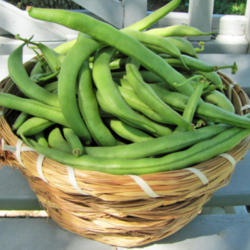
The most common bean diseases are: Anthracnose, bacterial blights, common bean mosaic, and rust.
Common Bean DiseasesAnthracnose is caused by a fungus, which is carried in seeds and lives in the soil on the remains of diseased plants. Rotating crops is important for control. You can recognize the disease by the brown, sunken spots that develop on the pods.
Bacterial blights cause large, brown spots on the leaves and water-soaked spots on the pods. The disease spreads quickly on wet foliage.
Common bean mosaic is caused by a virus carried in the seed and spread by aphids. Leaves become mottled and then curl. Some bean varieties are resistant to this disease.
Rust shows as red or black blisters on the leaves, which turn yellow and drop. The problem is caused by a fungus that lives through the winter on the remains of diseased plants.
Control StepsWhen anthracnose, blights or other bean diseases hit, there isn't too much you can do except to pull up and destroy seriously affected plants to prevent the disease from spreading to nearby plants. A few sprays are recommended to fight diseases. Contact your extension service agent for more information before using them. Extension agents are usually aware of which diseases have developed in an area and what the best controls are.
Disease Prevention StepsHere's a quick review of the basic steps to preventing disease problems in your garden:
 Victory Seed Company has all the seeds you want for your best garden in 2024.
Victory Seed Company has all the seeds you want for your best garden in 2024.
For 25 years, the family-owned Victory Seed Company has provided the highest quality vegetable, herb and flower seeds to families across the country. We are passionate about providing you the best seeds available that give excellent germination, robust plants, and the harvest you want. With a catalog of over a thousand varieties, we have everything, and our prices are the kinds that we'd want to pay. We have hundreds of yesterday's heirloom vegetables, as well as today's award winning hybrid selections. Get to know us by visiting our website and browsing through our online vegetable seed catalog.
| 1. Preserving Beans |
| 2. Watering & Fertilizing Beans |
| 3. Caring For & Harvesting Beans |
| 4. Bean Diseases ← you're on this article right now |
| 5. Bean Pests |
| 1. Preserving Beans |
| 2. Watering & Fertilizing Beans |
| 3. Caring For & Harvesting Beans |
| 4. Bean Diseases ← you're on this article right now |
| 5. Bean Pests |